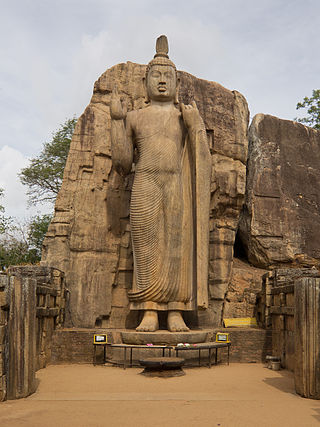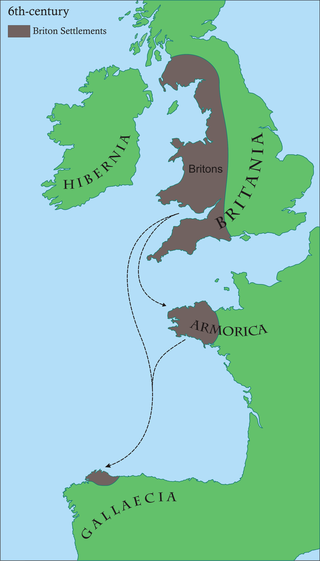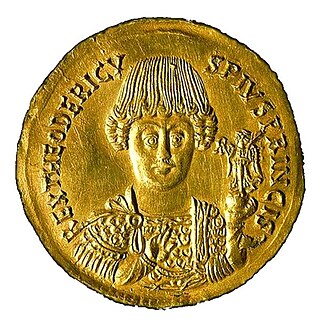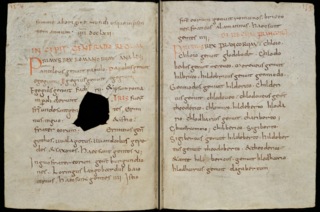See also
Name list
This page or section lists people that share the same given name. If an internal link led you here, you may wish to change that link to point directly to the intended article.
| Gender | masculine |
|---|---|
| Language(s) | Germanic |
| Other names | |
| Variant form(s) | Theodemar Theudemer Theudimer Theudemar Theudemir |
Theodemir, Theodemar, Theudemer or Theudimer was a Germanic name common among the various Germanic peoples of early medieval Europe. According to Smaragdus of Saint-Mihiel (9th century), the form Theudemar is Frankish and Theudemir is Gothic. [1]

The Ostrogoths were a Roman-era Germanic people. In the 5th century, they followed the Visigoths in creating one of the two great Gothic kingdoms within the Roman Empire, based upon the large Gothic populations who had settled in the Balkans in the 4th century, having crossed the Lower Danube. While the Visigoths had formed under the leadership of Alaric I, the new Ostrogothic political entity which came to rule Italy was formed in the Balkans under the influence of the Amal dynasty, the family of Theodoric the Great.

Theodoricthe Great, also called Theodoric the Amal, was king of the Ostrogoths (475–526), and ruler of the independent Ostrogothic Kingdom of Italy between 493 and 526, regent of the Visigoths (511–526), and a patrician of the Eastern Roman Empire. As ruler of the combined Gothic realms, Theodoric controlled an empire stretching from the Atlantic Ocean to the Adriatic Sea. Though Theodoric himself only used the title 'king' (rex), some scholars characterize him as a Western Roman Emperor in all but name, since he ruled large parts of the former Western Roman Empire, had received the former Western imperial regalia from Constantinople in 497, and was referred to by the title augustus by some of his subjects.
The 510s decade ran from January 1, 510, to December 31, 519.

Year 459 (CDLIX) was a common year starting on Thursday of the Julian calendar. At the time, it was known as the Year of the Consulship of Ricimer and Patricius. The denomination 459 for this year has been used since the early medieval period, when the Anno Domini calendar era became the prevalent method in Europe for naming years.

Year 510 (DX) was a common year starting on Friday of the Julian calendar. In the Roman Empire, it was known as the Year of the Consulship of Severinus without colleague. The denomination 510 for this year has been used since the early medieval period, when the Anno Domini calendar era became the prevalent method in Europe for naming years.

Theodoric is a Germanic given name. First attested as a Gothic name in the 5th century, it became widespread in the Germanic-speaking world, not least due to its most famous bearer, Theodoric the Great, king of the Ostrogoths.

At the Battle of Taginae in June/July 552, the forces of the Byzantine Empire under Narses broke the power of the Ostrogoths in Italy, and paved the way for the temporary Byzantine reconquest of the Italian Peninsula.

The Sciri, or Scirians, were a Germanic people. They are believed to have spoken an East Germanic language. Their name probably means "the pure ones".

This is a chronology of warfare between the Romans and various Germanic peoples. The nature of these wars varied through time between Roman conquest, Germanic uprisings, later Germanic invasions of the Western Roman Empire that started in the late second century BC, and more. The series of conflicts was one factor which led to the ultimate downfall of the Western Roman Empire in particular and ancient Rome in general in 476.
Desiderius is a Latin given name, related to desiderium - which can be translated as "ardent desire" or "the longed-for". Various other forms include Desiderio in Italian, Desiderio or Desi in Spanish, Desidério in Portuguese, Didier in French and Dezső in Hungarian.
The Amali – also called Amals, Amalings or Amalungs – were a leading dynasty of the Goths, a Germanic people who confronted the Roman Empire during the decline of the Western Roman Empire. They eventually became the royal house of the Ostrogoths and founded the Ostrogothic Kingdom.

The Ostrogothic Kingdom, officially the Kingdom of Italy, existed under the control of the Germanic Ostrogoths in Italy and neighbouring areas from 493 to 553.
Theodemir or Thiudimer was king of the Ostrogoths of the Amal Dynasty, and father of Theoderic the Great. He had two "brothers" named Valamir and Videmir. Theodemir was Arian, while his wife Erelieva was Catholic and took the Roman Christian name Eusebia upon her baptism. In the beginning of Theodemir's reign, he ruled together with his brothers-in-law as vassals under Attila the Hun. Most likely settling for this arrangement after his older brother had only managed a rule lasting four years. He eventually consolidated the three Gothic regions in Pannonia under his rule after the death of Vidimir, and later inheriting the lands of the childless Valamir as well. He was married to Erelieva, with whom he had two children: Theoderic (454–526) and Amalafrida. When Theodemir died in 475, Theoderic succeeded him as king over a combined Ostrogothic kingdom.
Amalafrida was queen of the Vandals by marriage to Thrasamund. She was the daughter of Theodemir, king of the Ostrogoths, and his wife Erelieva. She was the sister of Theodoric the Great, and mother of Theodahad, both of whom also were kings of the Ostrogoths.

The Kingdom of the Suebi, also called the Kingdom of Galicia or Suebi Kingdom of Galicia, was a Germanic post-Roman kingdom that was one of the first to separate from the Roman Empire. Based in the former Roman provinces of Gallaecia and northern Lusitania, the de facto kingdom was established by the Suebi about 409, and during the 6th century it became a formally declared kingdom identifying with Gallaecia. It maintained its independence until 585, when it was annexed by the Visigoths, and was turned into the sixth province of the Visigothic Kingdom in Hispania.

Theodemir or Theodemar was one of the last Suevic kings of Galicia and one of the first Chalcedonian Christians to hold the title. He succeeded Ariamir sometime between the end of May 561 and the year 566 and ruled until his death.
The pagan religion of the Germanic tribal confederation of the Franks has been traced from its roots in polytheistic Germanic paganism through to the incorporation of Greco-Roman components in the Early Middle Ages. This religion flourished among the Franks until the conversion of the Merovingian king Clovis I to Nicene Christianity, though there were many Frankish Christians before that. After Clovis I, Frankish paganism was gradually replaced by the process of Christianisation, but there were still pagans in the late 7th century.
Bonit or Bonitus may refer to:
Gundulf and its variants is a Germanic given name, from gund, "battle", and wulf, "wolf".

The Frankish Table of Nations is a brief early medieval genealogical text in Latin giving the supposed relationship between thirteen nations descended from three brothers. The nations are the Ostrogoths, Visigoths, Vandals, Gepids, Saxons, Burgundians, Thuringians, Lombards, Bavarians, Romans, Bretons, Franks and Alamanni.